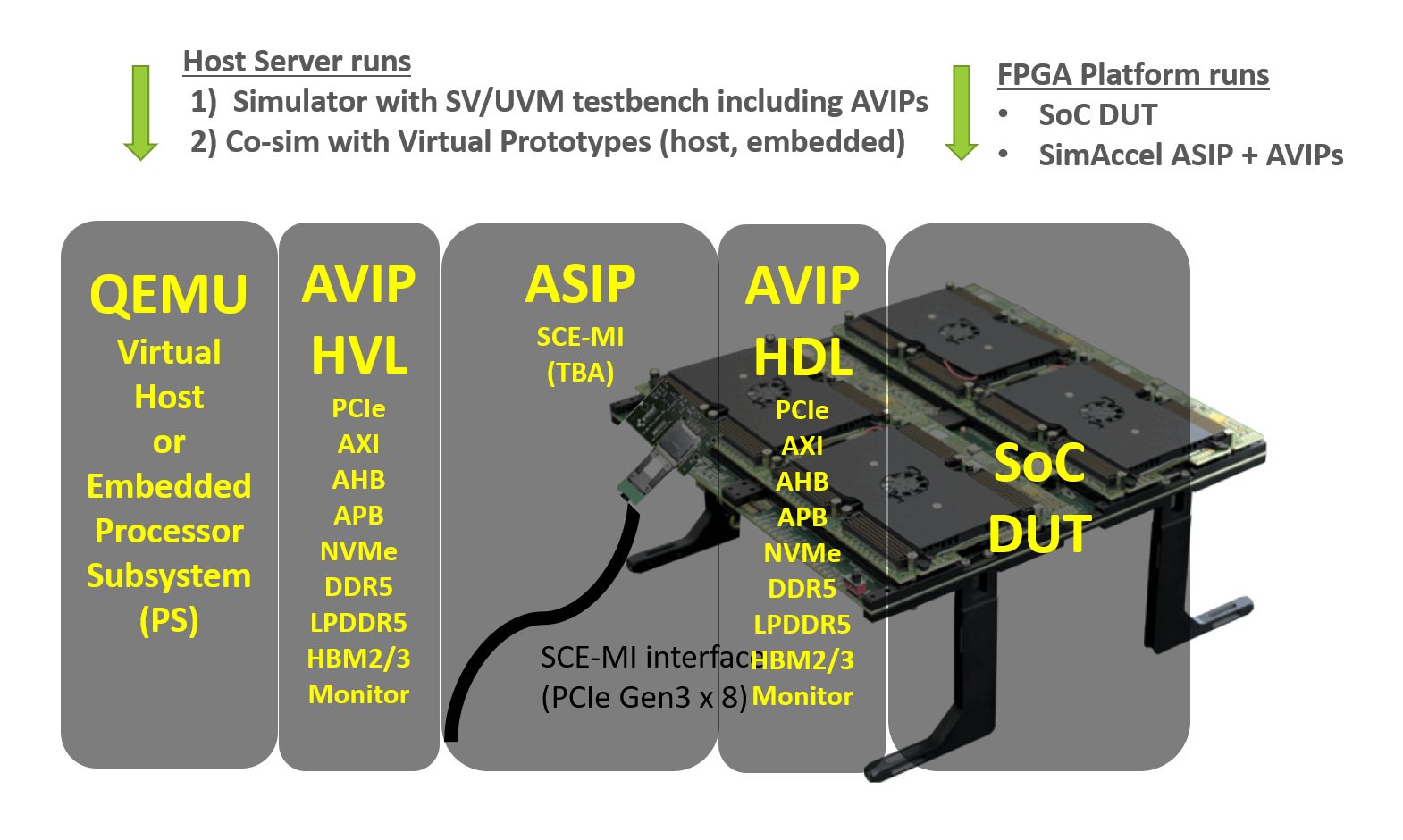- SimAccel combines advanced technology and methods for a comprehensive verification strategy
- RTL verification using VIP
- QEMU Virtual Host and embedded supporting x86, Arm, and RISC-V
- FPGA Prototyping
- Unified HW-SW Debug
- Full suite of Accelerated VIP
- PCIe, CXL, NVMe, DDR/LPDDR/HBM, AMBA, CPI/SFI, PIPE, LPIF
- This allows the creation of domain-specific accelerator solutions
- NVMe
- PCIe/CXL chips (switch, retimer) and IP core-level

SimAccel enables teams to 'Level Up' and 'Go Faster' for Better Productivity and Quality
SimAccel on desktop FPGA prototype system or Xilinx reference boards

FPGA Platforms
- S2C
- proDesign
- Xilinx
- Other multi-FPGA systems
| 440 US+ FPGA | Per Device | Total |
|---|---|---|
| System Logic (K) | 5,541 | 22,164 |
| CLB FF | 5,065 | 20,260 |
| Memory (Mb) | 88 | 354 |
| I/O | 1456 | 1456 |
| DDR4 (GB) | 64 | 512 |
SimAccel Key Features
- Accelerator System IP (ASIP)
- HW/SW Co-emulation IP includes
- HW is synthesized into main FPGA connected to Host PC (includes Xilinx PCIe/XDMA IP)
- Configurable number of AVIP sockets for AMBA and CPI transactors used for DUT or AVIPs
- SV DPI-based SCE-MI SW provides message transport to AXI transactors and utilizes Xilinx XDMA PCIe driver
- Xilinx Vivado FPGA projects for each target FPGA/Board
- HW/SW Co-emulation IP includes
- Accelerated VIPs (AVIPs)
- SV/UVM-based VIP compiled in AVIP mode
- Encrypted, synthesizable RTL/Netlist transactors plug into AXI slots in ASIP
- Leverages commercial IP cores to quality (Mobiveil, Xilinx)
- Enhanced GDB with Embedded HW Debug support for complete HW-SW co-debug
- HW waveform generation support including VCD/FSDB writer
- Automatic Multi-FPGA partitioner software
- Uses standard Vivado-based tool flow for synthesis through implementation
SimAccel NVMe Demo Performance
- Stress test performs 100 random NVMe read and write commands
- Data set varies transfer sizes between 1-2000 LBs/command
- LB size = 4KB
- Transfers range from 4KB – 8MB
- Run more long tests with large transfers (SGLs) on multiple submission queues and VFs
Virtual Prototyping and Co-Emulation, Co-Debug
- Using a single, unified debugger, the hardware and software engineers can carry out effective analysis and debug of the complete design
- HW/SW co-debug is supported through the use of GDB extensions for SimAccel
- Embedded debugging (EDB) commands
- Tightly controls HW and SW execution
- Access complete memory space
- SoC HW peripheral registers and memory (MMIO)
- AVIP embedded protocol trackers display current transactions
- SW callstack and program state
- Control SW and HW execution
- Set breakpoints on HW registers
- Value changes, expressions, error events, or timeouts
- Set breakpoints, watchpoints, catchpoints on SW program
- Program line or state change or expression
- Step program lines, time, clock cycles between
- Set breakpoints on HW registers

